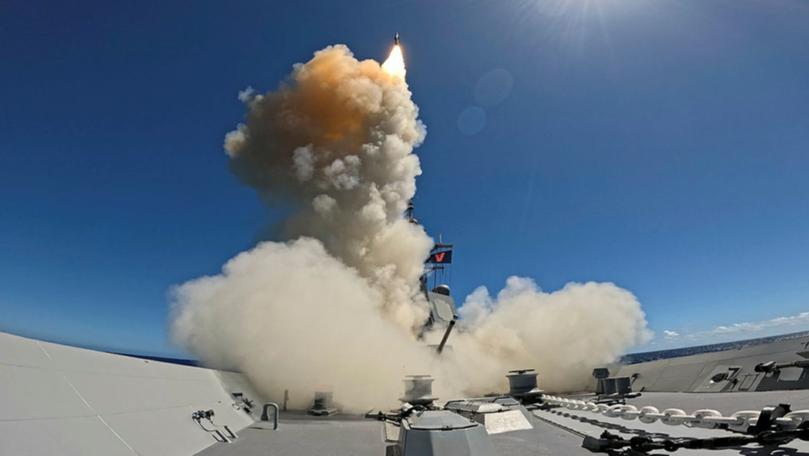Defence Industries Minister Pat Conroy reveals $7b price tag for US long and medium-range missiles

Australia’s navy will be able to strike targets hundreds of kilometres away and intercept incoming attacks with a mammoth $7 billion deal to buy long-range missiles from the US that give it the capacity to intercept ballistic missiles for the first time.
The US Congress has now approved the sale, which was ticked off by the State Department in August.
The deal means Australia will buy the medium-range and long-range missiles – known as the Standard Missile 2 Block IIIC and the Standard Missile‑6 – made by Raytheon in Tucson, Arizona, with Defence Industry Minister Pat Conroy revealing the price tag this week while on a trip to Washington.
Sign up to The Nightly's newsletters.
Get the first look at the digital newspaper, curated daily stories and breaking headlines delivered to your inbox.
By continuing you agree to our Terms and Privacy Policy.The weapons are the most advanced of their kind in the world and will be deployed in stages across the Navy’s fleet of Hobart class destroyers and the Hunter class frigates once they are built.
The US deployed the weapons against Houthi rebels in the Red Sea in December, marking their first intercept of a ballistic missile in combat.
Australia became the first nation other than the US to fire these missiles last year during an exercise near Hawaii.
The deal follows the Defence strategic review, which found Australia was unprepared as the world entered the missile age.
Professor Peter Dean — who contributed to the strategic review as a senior adviser — said the medium and long-range missiles had reaches of up to 200 and 300kms, respectively.
This compares to the navy’s current short-range missiles that have a reach of about 50km.
“The further out you can engage a target, destroy it and defeat it — the safer you are,” Prof Dean said.
“This provides us with a layered defence. Where you have long, medium and short range weapons and attackers must get through these different layers.”
In the wake of Russia’s full-scale invasion of Ukraine, global demand for longer-range missiles has skyrocketed, with production unable to keep up with demand.
Prof Dean said Australia’s acquisition of the technology — held tightly by the US military — demonstrated the strength of its relationship with America.
“The greatest limitation is global production. A huge number of US allies and partners are in the queue to get access to this technology right now,” he said.
“And that goes to show that we’re at the front of the queue.”

Mr Conroy said the $7 billion acquisition came as Australia faced the “most complex geo-strategic environment since the Second World War”.
“Our investment in these world-leading, high-tech missiles is another example of the Albanese Government moving fast to keep Australians safe, deter any adversary, and defend Australia’s national interests in the missile age,” he said.
“Australia was the first country, other than the United States, to fire the SM-6 missile, underscoring the strength of our alliance.”
Mr Conroy said “lots of countries” in the Indo-Pacific were investing in anti-ship missiles and aircraft to deliver the weapons.
“These missiles are designed to defeat that — either by destroying and attacking aircraft, or if they’re successful in launching a missile, destroying that missile in flight,” he said.
The minister would not specify when they would be rolled out for “operational reasons”.

Shadow Defence Minister Andrew Hastie welcomed the announcement but criticised the lack of “urgency” in securing the weapons.
“The Opposition welcomes the Government’s long overdue restoration of investment in air and missile defence platforms, after having cut spending in this area in Labor’s defence strategy and budget,” the WA-based MP said.
“But there is still no urgency, and no plan—with Labor unable to confirm when the new missiles will be deployed and whether our warfighters will have them in time.”
America’s Defense Security and Cooperation Agency said, announcing the proposed sale in August, that it would support the US’s foreign policy and national security objectives.
“Australia is one of our most important allies in the Western Pacific. Australia is strategically positioned to contribute significantly to ensuring peace and economic stability in the region,” the agency said.

Deputy Prime Minister and Defence Minister Richard Marles said the deal was another example of the Government’s success in acquiring critical capabilities for the ADF and “enhancing the lethality of Navy’s surface combatant fleet”.
The missiles would enable the Navy to strike maritime, land and air targets at long-range, and provide a terminal ballistic missile defence capability.
The Government is investing $54b to more than double the size of the nation’s warship fleet — from 11 to 26 by the mid-to-late-2040s.
The overhaul followed the strategic review findings that Australia had lost much of its geographical advantage in the missile age.
The SM-2 IIIC features active seeker technology and increases the Navy’s ability to defend against missile attacks.
The SM-6 missile means Australia now has terminal ballistic missile defence capability.
